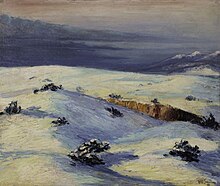American painter, sculptor and teacher (1893–1969)
William Howard Shuster Jr. (1893–1969) was an American painter, sculptor and teacher.
Youth
The Eve of Saint Francis , 1922Shuster was born November 26, 1893, in Philadelphia , Pennsylvania , as the second of three children.[ 1]
He served in the U.S. Army during World War I in France, where he developed tuberculosis after being gassed .[ 2]
New Mexico
New Mexico Snow Country , 1921In 1920, Shuster moved to New Mexico [ 3] improve his health and became friends with the small but growing arts community. Shuster made money doing ironwork and painting to supplement the pension.[ 4] Los Cinco Pintores ("the five painters"), and showed throughout Santa Fe and the rest of the country with the group.
Oeuvre
Portrait of John Sloan , 1928His artwork is in the permanent collections of the Stark Museum of Art , Brooklyn Museum , Delaware Art Museum , Newark Museum , and New Mexico Museum of Art .[ 5]
undated — Senator Bronson Cutting (bronze bust)
undated — Avanyu 1
undated — Avanyu 2
undated — Prayer for the Hunt
undated — Portrait of Teresa Bakos
undated — 40th Wedding Anniversary
1921 — New Mexico Snow Country
October 1922 — The Eve of Saint Francis
1924 — Zozobra , a giant puppet now burned every year in effigy, and symbolizing the gloom of the passing year.
1927 — New Mexico Mountain Scene
1928 — Portrait of John Sloan
1929 —The Santo Domingo - Corn Dance
c. 1930 — Trees at Canyoncito c. 1934 — Eagle Dancer (study for The Voice of the Sky )1934 — Winnowing Wheat
May 28 - August 8, 1934 — The Voice of the Earth (The Basket Dance)
1934 — Pottery Maker
May 28 - August 28, 1934 — The Voice of the Water (The Spring Flute Ceremony)
1934 — Sermon at Cross of the Martyrs
1935 — The Voice of Sipapu (The Kiva)
c. 1940 — Sketchbook September 14 - October 12, 1943 — The Voice of the Sky (The Eagle Dance)
1949 — Untitled (Deer Dance) [ 6]
1952 — El Toro , a symbol for the Santa Fe Rodeo.
1964 — Zozobra Mural
Notes and references
^ John Sloan ~ Will Shuster: A Santa Fe Friendship . Santa Fe, NM: The Peters Corporation. 1993. ISBN 0935037497 ^ Dispenza, Joseph & Louise Turner (1989). Will Shuster: A Santa Fe Legend . Santa Fe, NM: Museum of New Mexico Press. ISBN 0890131988 ^ "Oral history interview with Will Shuster" . Archives of American Art, Smithsonian Institution. Retrieved 16 January 2014 .^ Robertson, Edna (1975). Los Cinco Pintores . Santa Fe: Museum of New Mexico Press. ISBN 0890130809 ^ Lewandowski, Stacia (2011). Light, Landscape and the Creative Quest : Early Artists of Santa Fe . New Mexico: Salska Arts. p. 144. ISBN 9780615469171 ^ "Untitled (Deer Dance)" . 1949.
External links
International Artists Other


